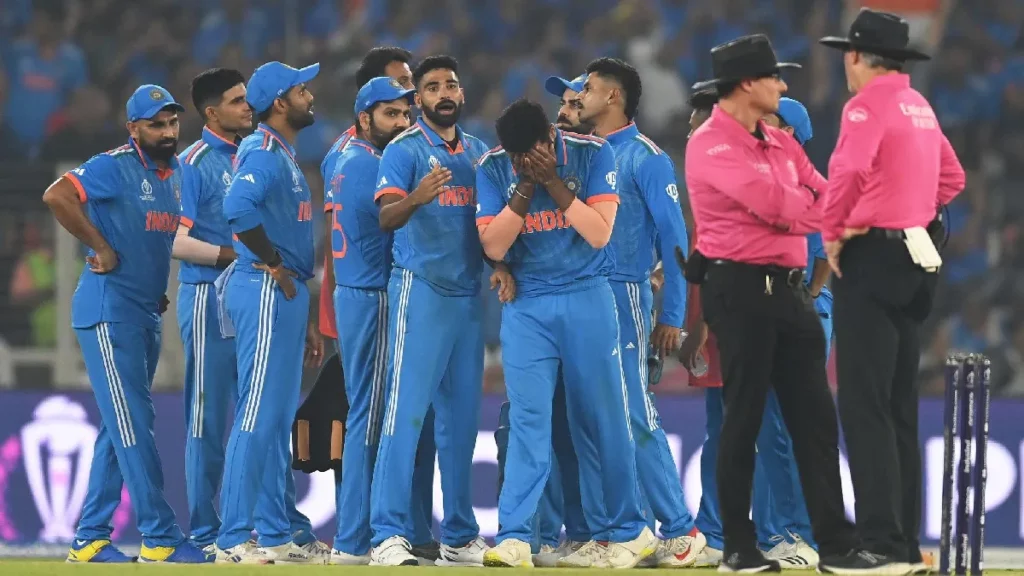On Sunday, Team India suffered a sad defeat to Australia in the 2023 ODI World Cup final at the Narendra Modi Stadium in Ahmedabad. The Men in Blue’s epic home campaign did not finish happily, with Australia claiming their record-extending sixth title with a comprehensive six-wicket triumph.
Rohit Sharma and company had played near-perfect cricket throughout the season to go undefeated in the league stage, as well as a resounding triumph in the semi-finals. Their unwelcome affair with sadness, however, continues as the current setback extended their ICC silverware drought even further.
While India will take many positives from the tournament, it will be the little downsides from which they will learn and progress. Skill-wise, the present club was maybe one of the finest white-ball sides to ever exist, but as is sometimes the case with some teams, they just couldn’t click when it meant the most.
The intense strain of the finals, along with Australia’s dogged chase and the circumstances, perhaps stacked the odds against the Indians, who could not overcome despite being in top shape.
The failures in Dhaka, Sydney, Mumbai, London, Manchester, and Adelaide have taught the Indian squad a lot, and Ahmedabad 2023, sadly, becomes another item on the lengthy list rather than a meaningful success.
On that point, let us look at three major takeaways from India’s 2023 World Cup final loss to Australia.
1. Live by the sword, die by the sword rewrite heading

In the middle overs, Team India was one of the strongest performing teams, particularly with the bat. The in-form hitting team dominated the second powerplay, rotating strike and scoring boundaries at will.
Even without the ball, they were a formidable force in the middle overs. Following the devastation caused by the new ball bowlers’ initial spells. In the middle overs, the spinners usually stepped up, keeping things tight and chipping in with wickets. The pacers were equally productive with the old ball in their second period, laying the groundwork for the death overs.
However, it was in the middle overs of the finals where India arguably lost both the bat and the ball. Team India scored 80 runs in the first powerplay, but the fear of losing wickets led in only a handful of boundaries in the whole middle-over period, the lowest for India since July 2011.
On the bowling front, the Men in Blue battled their way back into the game with three wickets in the first powerplay, then faded. Travis Head and Marnus Labushcagne handled the situation appropriately, with the dew also playing a role. The Indian spinners were extremely ineffective and went out without a wicket for the first time in the competition.
2. India can balance their batting and sixth bowling options
One of the most talked-about worries regarding the Indian side heading into the World Cup was the No.8 slot in the batting order or the likelihood of a sixth bowler in the set-up, especially after the middle-order proven itself.
Following Hardik Pandya’s injury, the Men in Blue had to take a new path. With Mohammed Shami and Suryakumar Yadav in the playing XI, the squad prospered, but despite the victories, it was clear that India required a sixth bowling option and some batting depth in case tragedy hit.
The final came about the situation that the team and supporters had feared: India had to take a cautious approach in the early middle overs, with Suryakumar Yadav coming in as the last recognized batter at No. 7.
When none of the bowlers could make an impression and break the fourth-wicket stand, Rohit Sharma had no one to turn to with the ball.
3. Pacing the innings and saving wickets for the end
After losing three wickets, India and Australia found themselves in a similar scenario with the bat. While the Men in Blue were cornered, their counterparts battled through the storm and faced the consequences.
The weather aided Australia, but so did their optimistic attitude. They didn’t let the Indian bowlers settle in and made it a point to score a boundary off each over, ideally on the opening few of deliveries.
Furthermore, every time India appeared to be settling in and on the verge of taking risks and accelerating, they lost a wicket. It was not a surface where the new hitter could relax right away, so the new duo constantly had to start from scratch with the lack of hitting in the lower middle order playing on their thoughts.




